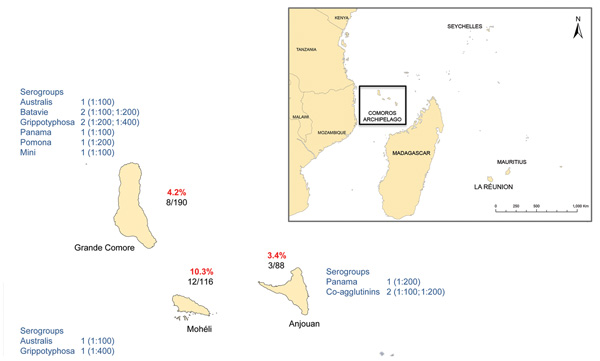Volume 20, Number 4—April 2014
Letter
Serologic Evidence of Leptospirosis in Humans, Union of the Comoros, 2011
Figure

Figure. . Microagglutination test results, showing serologic evidence of leptospirosis in humans, Union of the Comoros, 2011. The percentage of positive cases is shown for each island; the number below the percentage indicates the number of positive serum samples/total number tested. The serogroups identified on each island are shown; numbers represent the number of positive serum samples and, in parentheses, the number of corresponding titers. When agglutination was observed with >1 serogroup, the serogroup with a titer difference >2 relative to other serogroups was considered to be the infecting serogroup; when no serogroup had a titer difference >2 relative to other serogroups, coagglutinins were considered to be present in the serum sample. Data for Mayotte Island are from previous studies (2,4).
References
- Bourhy P, Collet L, Lernout T, Zinini F, Hartskeerl RA, van der Linden H, Human Leptospira isolates circulating in Mayotte (Indian Ocean) have unique serological and molecular features. J Clin Microbiol. 2012;50:307–11. DOIPubMedGoogle Scholar
- Picardeau M. Diagnosis and epidemiology of leptospirosis. Med Mal Infect. 2013;43:1–9. DOIPubMedGoogle Scholar
- Bourhy P, Collet L, Clément S, Huerre M, Ave P, Giry C, Isolation and characterization of new Leptospira genotypes from patients in Mayotte (Indian Ocean). PLoS Negl Trop Dis. 2010;4:e724. DOIPubMedGoogle Scholar
- Pappas G, Papadimitriou P, Siozopoulou V, Christou L, Akritidis N. The globalization of leptospirosis: worldwide incidence trends. Int J Infect Dis. 2008;12:351–7. DOIPubMedGoogle Scholar
- Simon F, Morand G, Roche C, Coton T, Kraemer P, Fournier P-E, Leptospirosis in a French traveler returning from Mauritius. J Travel Med. 2012;19:69–71. DOIPubMedGoogle Scholar
- Rahelinirina S, Léon A, Harstskeerl RA, Sertour N, Ahmed A, Raharimanana C, First isolation and direct evidence for the existence of large small-mammal reservoirs of Leptospira sp. in Madagascar. PLoS ONE. 2010;5:e14111. DOIPubMedGoogle Scholar
- Socolovschi C, Angelakis E, Renvoisé A, Fournier P-E, Marié JL, Davoust B, Strikes, flooding, rats, and leptospirosis in Marseille, France. Int J Infect Dis. 2011;15:e710–5. DOIPubMedGoogle Scholar
- Desvars A, Naze F, Vourc’h G, Cardinale E, Picardeau M, Michault A, Similarities in Leptospira serogroup and species distribution in animals and humans in the Indian Ocean island of Mayotte. Am J Trop Med Hyg. 2012;87:134–40. DOIPubMedGoogle Scholar
- Lagadec E, Gomard Y, Guernier V, Dietrich M, Pascalis H, Temmam S, Pathogenic Leptospira spp. in bats, Madagascar and Union of the Comoros. Emerg Infect Dis. 2012;18:1696–8. DOIPubMedGoogle Scholar